#spanish history
Text
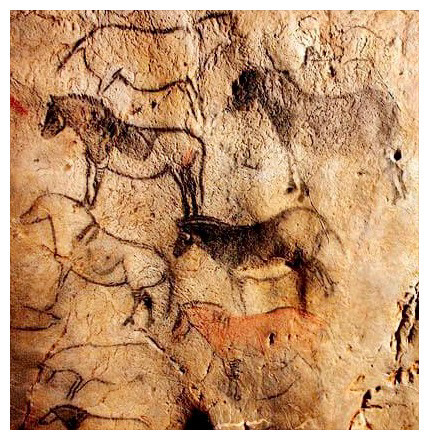
Cave Paintings
Ekain Cave, Sastarrain Valley, Spain
Magdalenian period (10,000- 14,500 years ago)
#ekain cave#spain#art history#horse#petroglyphs#cave art#cave paintings#beautiful horse#beautiful animals#early humans#aesthetictumblr#spanish history#spanish art#tumblraesthetic#tumblrpic#tumblrpictures#tumblr art#tumblrstyle#artists on tumblr#aesthetic#beauty#ancient art
406 notes
·
View notes
Text
fun fact there is a spanish painter called Antonio López García who paints incredibly hyperrealistically and is so well known and demanded that the spanish royal family asked him to paint them and it took him actual literal 20 years to finish it and it is a fucking banger
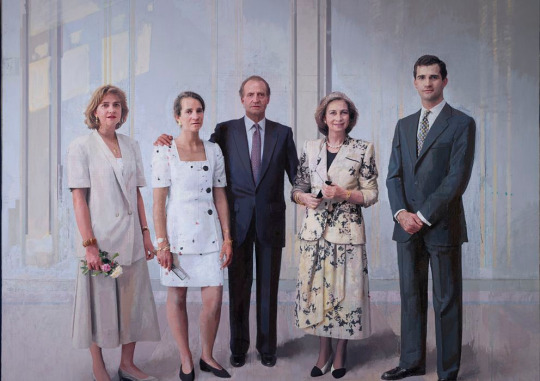
To put into perspective how long it took him. Google wasn't a thing when he started the painting

And this is a picture of the royal family that was taken the year the painting was finished and put in the royal palace in Madrid, in 2014
He's also got other famous paintings, like this one of one of the main roads in Madrid completely devoid of cars that was finished 40 years before the pandemic, where the landscape would become a reality

#nathan's notes#history#spanish history#antonio lopez#i don't know I just felt like talking about this guy#we talked about him in my art history class and i think he's very cool#he's still alive btw
394 notes
·
View notes
Text
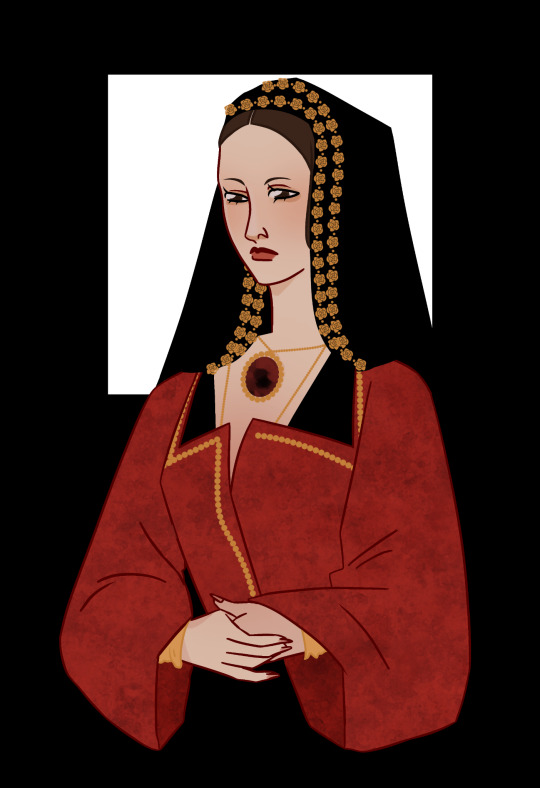
#history art#juana i of castile#art#digital illustration#taniata's art#spanish history#women in history
72 notes
·
View notes
Text
Another of my favorite etymologies is el aquelarre which is "a coven (of witches)"
It is most likely derived from Basque where it meant "meadow of the male goat", almost definitely a reference to the Devil and how Christianity turned former symbols into devil motifs
The word "aker" as "billy goat" or "male goat" also appears in Akerbeltz, which means "black goat" and it was something very similar to Pan in Greek mythology (and other European mythologies), where it was a symbol of animals and nature; then Christianity came in and turned the goat into one of the symbols of the Devil [horns, goat motifs, cloven feet/having hooves], and so the Akerbeltz became a symbol of demon worship by pagans
Again, common in other European countries where different horned animals or deities were linked to devil worship because Christianity
The word aquelarre also can mean "witches' Sabbath", where supposedly witches met to reaffirm their vows - like the opposite of nuns. Usually these supposed meetings were in fields or forests or in the mountains [like Bald Mountain in Slavic folklore, or something similar to Walpurgis Night in Germanic folklore]
91 notes
·
View notes
Text
So I was watching one of those movie channels today and uh I noticed something interesting in Cinderella (2015):


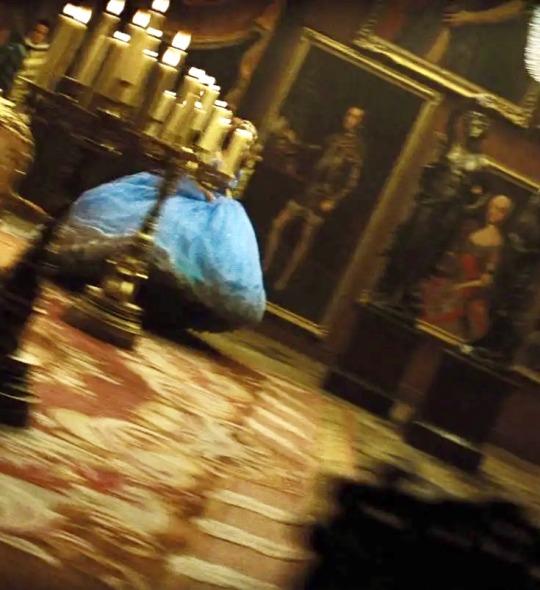

Phillip II of Spain cameo
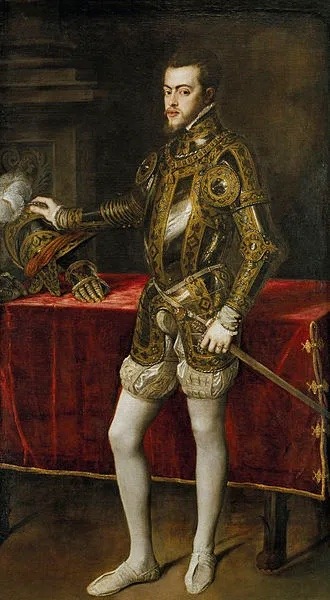
Of course he’s in a fucking Princess movie. Of course
#philip ii of spain#mary i#cinderella#cinderella 2015#catherine of aragon#anne boleyn#tudor history#henry viii#the tudors#english history#tudor era#jane seymour#tudor rose#tudor period#tudor england#spanish princess#spain#spanish art#spanish history
54 notes
·
View notes
Photo
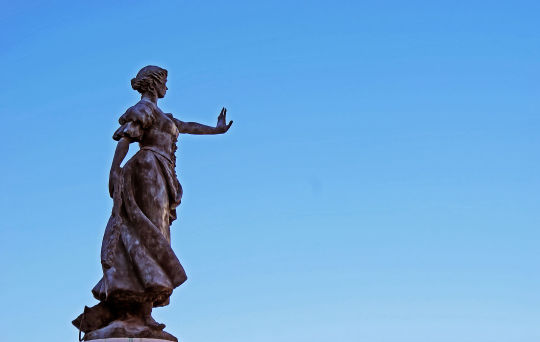
(Photo: Carmen Escobar Carrio)
Juana Galán - Heroic guerrillera
When the French invaded Spain during the Peninsular War, some women were determined to resist. Among them was Juana Galán (1787-1812), the daughter of a prosperous tavern keeper.
On June 6, 1808, a column of 1,000 enemy troops attacked the town of Valdepeñas. Juana rallied the townswomen under her command. They manned the windows and threw boiling water and oil at the enemy.
Juana went to the street armed with a club. She reportedly pulled several French soldiers from their horses and dispatched them with a blow to the head. The townspeople’s fierce resistance forced the French to retreat and never return.
Juana didn’t live to see the end of the war. She died in 1812 while giving birth to her daughter. Her legacy lives on and she was made a local heroine and a symbol of resistance. She now has her own monument in Valdepeñas.
Like Juana, other women fought in desperate situations or during riots, sometimes with improvised weapons. In 1809, an unnamed woman armed with a sword rallied the inhabitants of Penafiel (northern Portugal) and led them in battle against the raiders. In 1811, María Marcos, a tavern keeper from La Palma del Condado, played a key role in repelling a small group of French soldiers.
There were also cases of women involved in guerrilla warfare. The Catalan Somatén, a paramilitary defense organization, had female members such as María Escoplé, Magdalena Bofill, Margarita Tona, María Catalina and Catalina Martín. Francisca de la Puerta reportedly fought in Extremadura and commissioned the Junta of her province for permission to form her own guerrilla band.
Wanting to avenge her father and brother, Martina de Ibaibarriaga Elorriagafora disguised herself as a man and led a guerrilla band until she gained a commission in the Spanish army. An unnamed woman was given the command of a troop by the Junta of Molina de Aragón in 1809. A British officer also mentioned women serving with bands of irregulars as active combatants.
For more heroines of the Peninsular War, see Agustina de Aragón.
Feel free to check out my Ko-Fi if you want to support me!
Further reading
Esdaile Charles J., Women in the Peninsular War
Sheldon Natasha, “Juana Galan: A Spanish Heroine of the Peninsula War”
#Juana Galán#history#women in history#spain#spanish history#peninsular war#napoleonic wars#19th century#women's history#warrior women#war#women warriors#historyblr#badass women#historicwomendaily#historical ladies#warriors
68 notes
·
View notes
Text
Time Travel Question 26: Ancient History XIV and Earlier
These Questions are the result of suggestions from the previous iteration.
This category may include suggestions made too late to fall into the correct grouping.
Please add new suggestions below if you have them for future consideration. All cultures and time periods welcome.
#Dʿmt#Time Travel#Ötzi#Bronze Age#Prehistory#The Bible#Siddhartha Gautama#Jesus of Nazareth#Religious History#Early Humans#Ötzi the Iceman#Textiles#History of Textiles#Ethiopian History#Slavic History#Lechitic Peoples#Lost Literature#The Tully Monster#Iberia#Spanish history#Ancient World
89 notes
·
View notes
Photo

Agustí Centelles. German bombing over Lleida. 1937
Follow my new AI-related project «Collective memories»
#BW#Black and White#Preto e Branco#Noir et Blanc#黒と白#Schwarzweiß#retro#vintage#Agustí Centelles#Spanish Civil War#Spain#Spanish history#1937#1930s#30s#war#guerra#history#historico#histoire#história#Geschichte#記録#史籍#由来#historia#histórico#historyczny#역사#역사적
32 notes
·
View notes
Text
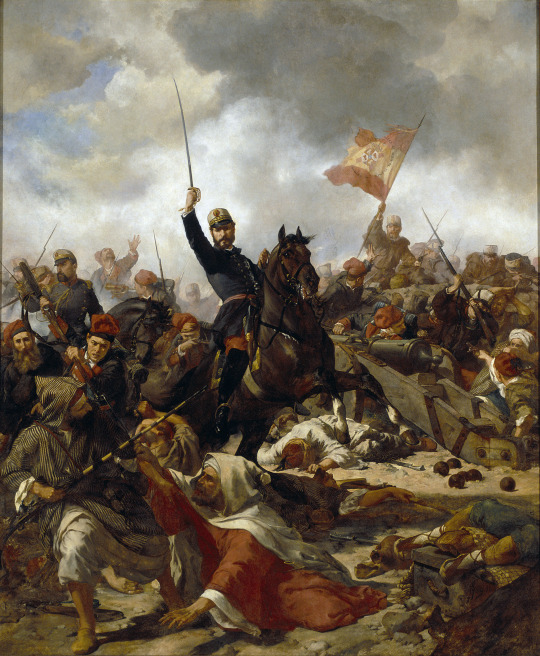
Francesc Sans Cabot (Spanish, 1834-1881)
General Prim at the Battle of Tetuan, 1865
Museu Nacional D'Art De Catalunya
#Francesc Sans Cabot#spanish#spanish art#1800s#art#fine art#european art#classical art#european history#spanish history#tetuan#general prim#battle of tetuan#europe#european#oil painting#fine arts#mediterranean#europa#southern europe#classic art#art history#historical art#spain#espana#traditional art#hispanic
89 notes
·
View notes
Photo
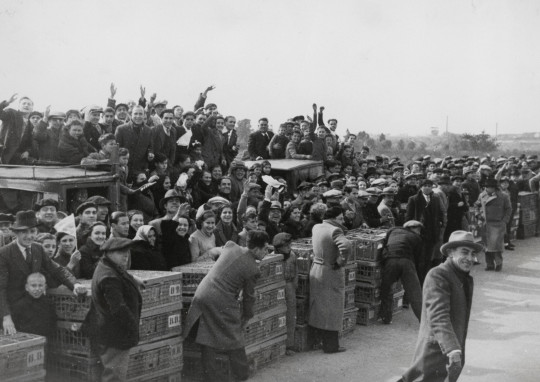

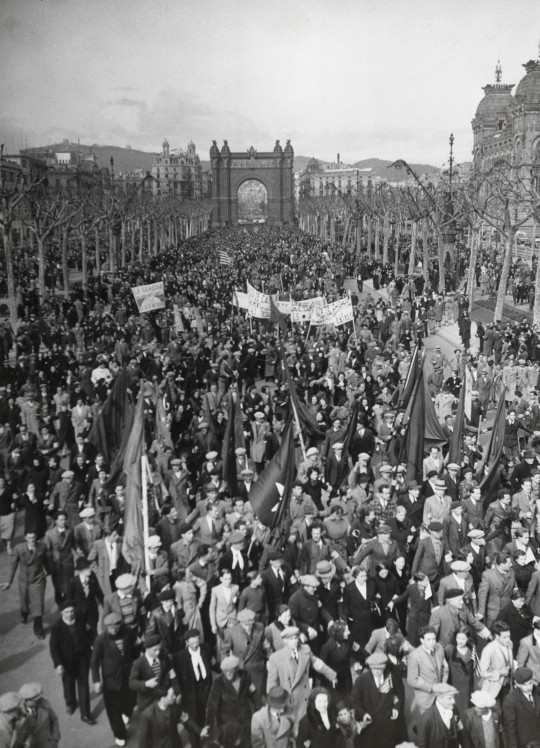

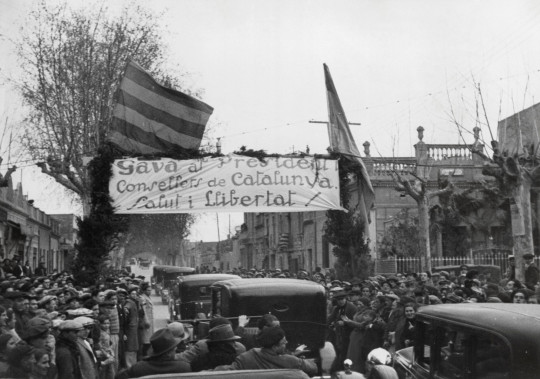

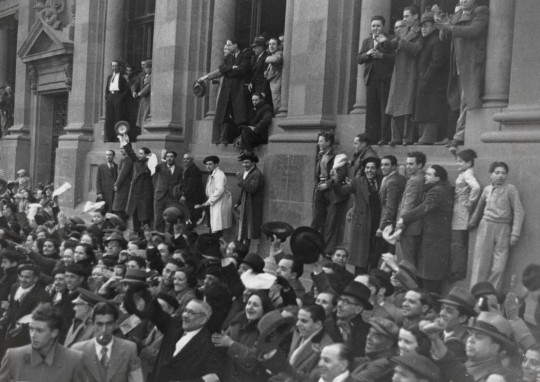

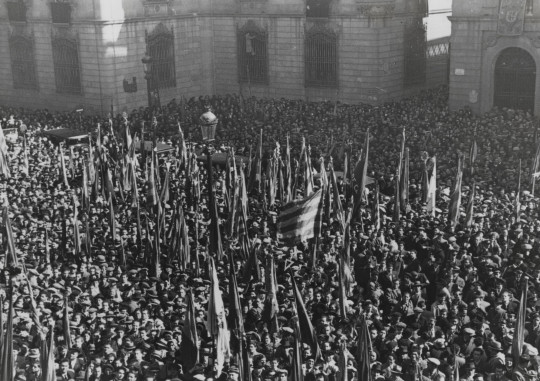

1st of March, 1936.
People on the streets of Barcelona (capital city of Catalonia) welcoming the president of Catalonia Lluís Companys and other members of the democratically-elected government of Catalonia, who had been arrested and jailed after the October Events (Fets d’Octubre) of 1934.
Context: As the Spanish government became more and more conservative, leaving important decision-making positions to fascists and reactionary monarchists, Catalonia was leaning every time more towards the left and republicanism (anti-monarchy). The Republican Left of Catalonia (ERC) party had won the elections in Catalonia and the anarchist union CNT kept growing in members. The difference was absolute. And it got even worse when the Spanish Government cancelled the newly approved law of the Catalan Government that protected landless agricultural workers against the abuses of landowners (the Spanish Government claimed that important decisions like this were exceeding the power of a regional government, even when Catalonia’s inhabitant massively claimed in favour of this law).
To put an end to this situation, the government of Catalonia organized a Revolutionary Committee (Comitè Revolucionari) with people from many different Catalanist organizations to prepare a response. Most trade unions declared a general strike against the Spanish government and, on October 6th, Lluís Companys went on the balcony of the Government of Catalonia (the balcony overlooks a big square where a huge crowd had gathered) and declared the Catalan state inside the Spanish federation.
As a response, the Spanish government declared the state of war in Catalonia and sent the army to arrest all the Catalan government. The Spanish army shot against the population who was defending the institutions, killing 74 people and injuring 252, including members of the Catalan Proletarian Party, the Communist Party of Catalonia, Catalan State, the Workers’ and Peasants’ Block, the CNT, and other civilians. On the other side, the revolutionaries who defended themselves from the army killed 12 soldiers and 2 military policemen (guardia civil), and 10 civilians who died as part of crossed fire.
The Catalan State only lasted 10 hours. The Spanish army, on top of killing and injuring all those people, also arrested more than 3,500 people, including all members of the democratically-elected Government of Catalonia, many mayors and MPs, and leaders of other Catalan leftist parties and unions. The members of the Government of Catalonia were judged and sentenced to 30 years of prison, the Government of Catalonia was abolished and Catalonia became direct subject of a Spanish military governor chosen by the Spanish government. 129 city councils around Catalonia, where the election winner had been ERC, were also abolished and given to conservative parties. The Spanish government also used the opportunity to once again impose Spanish as the only language to be used in official documents in Catalonia (during the Republic, Catalan had been legalized); ban many of the most popular Catalan newspapers, including La Publicitat, L’Opinió, La Humanitat, El Diluvio, Solidaridad Obrera (this one is the CNT’s newspaper) and La Rambla; turned the Parliament of Catalonia into a military barrack; prohibited the activities held by pro-Catalan/leftist parties, unions and associations and closed their headquarters. Of course, they also made sure that the law that protected the agricultural workers remained illegal, and did 1,400 trials against landless agricultural workers affected by this law to evict them from the fields.
The Spanish Government didn’t lift the state of war in Catalonia until April 1935. The Government of Catalonia was restored but with little power, it wouldn’t get back the power that it had before the October Events (which, as you saw, already wasn’t that much) and restore democracy in Catalonia until the general elections of February 16th 1936. The leftists won the elections and the people in prison for the October Events were given an amnesty, this is where the pictures you saw above are from.
However, this reinstalled (partial) democracy did not last for long. The fascist Spanish nationalists are sore losers and couldn’t accept that the right-wing had lost the elections in Spain, so they did a coup, starting the Spanish Civil War (1936-1939). The war would be won by the fascists, starting a fascist dictatorship that lasted until 1978, based on the concepts of national-Catholicism, anti-labour, hatred of national minorities like Catalans, and strict patriarchal gender behaviour codes.
Knowing that they would be killed if found by the fascists, Lluís Companys and the rest of members of the Government of Catalonia left Barcelona at the last moment, when the fascist troops were entering the city. They escaped to France, but the Spanish fascist government asked the Gestapo (secret police of Nazi Germany) to search for them and sent them to Spain. In August 13th 1940, the Gestapo found Lluís Companys in Paris, arrested him and sent him to Madrid (Spain’s capital city). He was judged by a military court-martial and sentenced to death, and the next day he was executed. He was 58 years old. His last words, right before getting shot, were “for Catalonia!”.
Lluís Companys is the only democratically-elected president to have been executed by a fascist government in Europe’s history. Between the entrance of fascist troops in Barcelona (January 26th 1939) and Lluís Company’s execution (October 15th 1940), the Spanish fascist government had already officially executed 2,760 people in Catalonia, and more would follow.
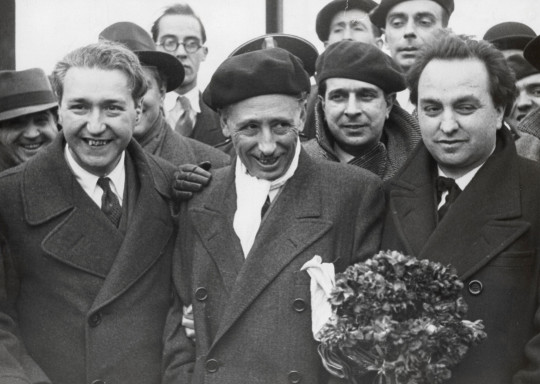
In the centre of the photo, Lluís Companys (the one wearing a beret) receiving a flower bouquet upon his return to Catalonia after the amnesty.
(Photos: Arxiu Fotogràfic de Barcelona)
#història#catalunya#lluís companys#barcelona#spanish civil war#catalonia#democracy#history#20th century history#1930s#historical photos#historical#catalan#independence#european history#spanish history#guerra civil#photojournalism#antifascist#antifa#national liberation
46 notes
·
View notes
Text
On This Day In History
October 27th, 2017: Catalonia declares independence from Spain. The Spanish government responded by imprisoning several Catalonian leaders (later pardoned) and enforcing stricter rule on the region.
56 notes
·
View notes
Text

"Jewish Life in Medieval Spain is a detailed exploration of the Jewish experience in medieval Spain from the dawn of Sephardic society in the ninth century to the expulsion of 1492. An important contribution of the book is the integration of the rise and fall of Jewish life in Muslim al-Andalus into the history of the Jews in medieval Christian Spain. It traces the collapse of Jewish life in Muslim Spain, the emigration of Andalusi Jewry to the lands of Christian Iberia, and the long and difficult confluence of these two distinct Jewish subcultures."
179 notes
·
View notes
Text








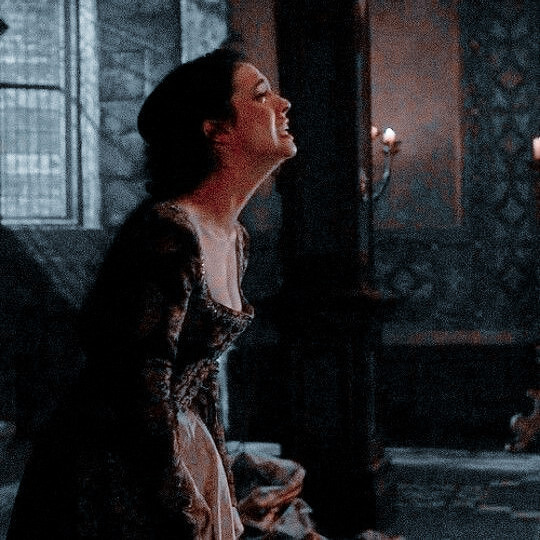
– juana i de trastámara ; infanta of spain, duchess consort of burgundy, queen of castile, aragon, valencia, mallorca, navarre, naples, sicily, sardinia and countess of barcelona was born on this day, 6th of november of 1479
#juana i de castilla#joanna of castile#juana the mad#house of trastamara#spanish history#on this day in history#weloveperiddrama#women in history#perioddramaedit#isabel tve#la corona partida#irene escolar#myedit*
52 notes
·
View notes
Photo



‘Catalina, still getting used to hearing the sharp consonants of her name softened to the English word ‘Catherine’, was one month off her sixteenth birthday [when she married Arthur]. She was, or certainly should have been, a virgin. That, anyway, was what the ambassadors sent by her parents, Isabel and Ferdinand, the powerful Reyes Católicos – the ‘Catholic Monarchs’ – of Spain, had proclaimed to her father-in-law and his court just twenty-four hours earlier. Her husband, Arthur, prince of Wales and heir to the throne of England, may have been younger, but his fourteenth birthday was already thirteen months behind him. Catherine herself had been of a marriageable and (by presumption, at least) sexually mature age for even longer. The wedding treaty had stipulated a marriage after Arthur’s fourteenth birthday. By the mores of their time, then, they were old enough for what should have happened next.’ – G. Tremlett, Catherine of Aragon: The Spanish Queen of Henry VIII.
#catherine of aragon#katherine of aragon#the tudors#historyedit#perioddramaedit#perioddramacentral#tudors#spanish history#english history#giles tremlett#historicaledit#tudorsedit#isabel tve#**
200 notes
·
View notes
Text
As I promised, let's start with the bookscans:
Al-ANDALUS. PERSONAJES HISTÓRICOS
(Al Andalus. Historical figures)
Concepción Masiá
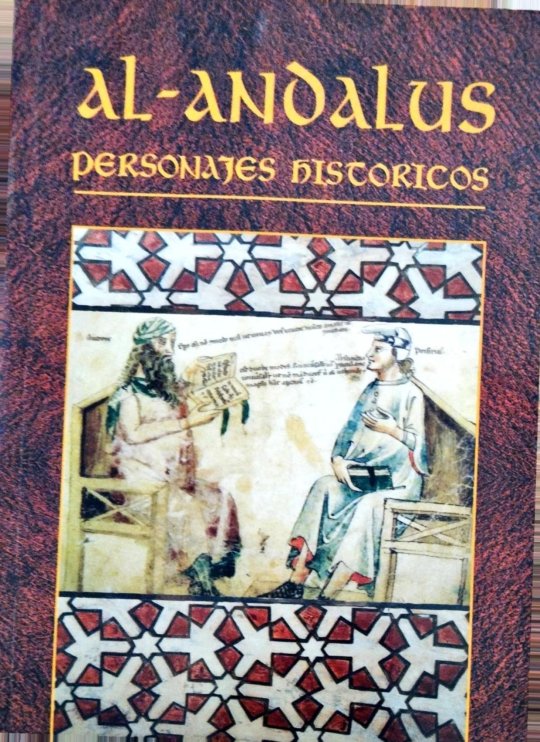
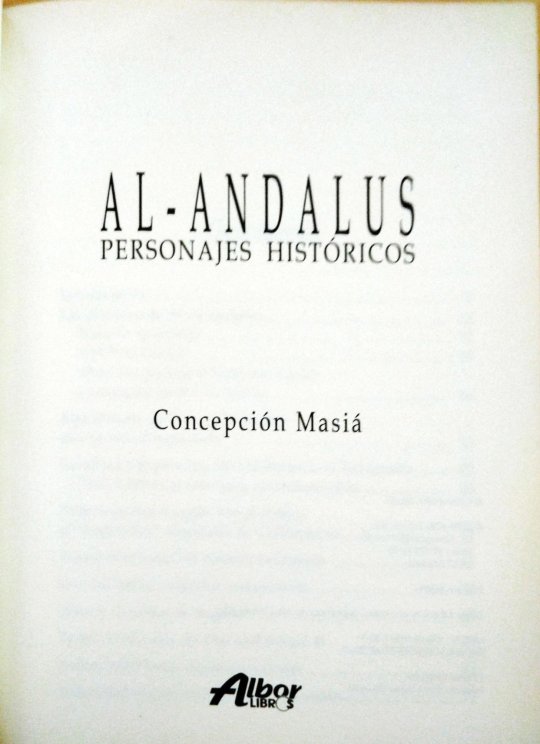

Summary
Introduction.................................. 9
The precursors of al-Andalus.....13
Count Don Julián....................13
Tarif ben Malluk. ....................15
Musa ben Nusayr and Tariq ben Ziyad: the conquerors of Spania...........16
Abd al-Aziz: a good governor with an unfortunate fate ..........................25
The Odyssey of Prince Abd al-Rahman the Immigrant......................................29
Abd al-Rahman was only twenty-five years old.........................................36
Sulayman ben Yaqzan ben al-Arabi: Charlemagne's deceived "deceiver" ........................... ...........41
Amrus ben Yusuf: the muladí of Huesca
.............................................................47
The “rabadies”: adventurous spirits.. ..............................................53
Ziryab: the singer of Baghdad........61
Tarub: the favorite of Abd al-Rahman II...............,...........................................67
Abbas ben Firnas: the first aviator............................ ......................73
Yahya ben Hakan al-Bakri: the miserly poet.....................................................77

Abd al Chabbar and Sulayman ben Martin: the rebels of Mérida..........................81
Eulogio and Álvaro de Córdoba:
pursuing martyrdom..........................85
The Andalusian Vikings..................... 95
The emir Abd Allah distrust and death...............................….................... 101
Musa ben Musa ben Qasi: the third king of Spain.......................................................107
Ibn Hafsun: the unredeemed rebel.....115
Abu Alí al-Sarrach: the Andalusian missionary. ...........................................125
Ibn Masarra: a freethinker in Spanish Islam.......,...........,...................................131
Abd al-Rahman III:
the first independent caliph of al-Andalus. ...........,................................137
Hasday ibn Shaprut:
the Jewish doctor of Abd al-Rahman III............ ....... ...................... ................... 145
Andalusians in France: the “Moorish kingdom” of Fraxinetum....................... 151
Rabbi ben Zayd: Bishop Recemundo............................................. 157
Al-Hakam al-Mustansir bi-llah:
passion for culture.................................. 161
Ibn Abd Rabbhi, the encyclopedist,
and Ibn Futais, the collector.................. 167
Al-Mansur “the Victorious” ...................171
Hisham II and Sanchuelo: misrule. .......191
Abu Muhammad Ali ibn Hazm:
The pigeon neackle................................209
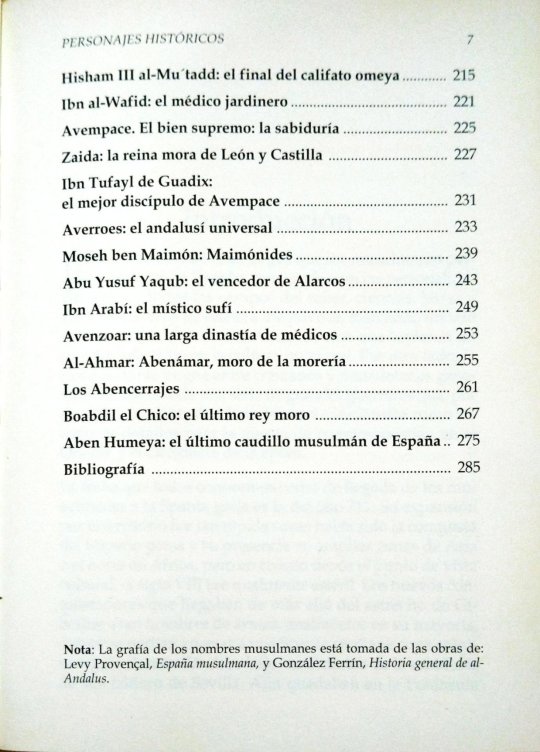
Hisham III al-Mu'tadd: the end of the Umayyad caliphate...............................215
Ibn al-Wafid: the gardener doctor.....221
Avempace. The supreme good: wisdom...................................................225
Zaida: the Moorish Queen of Leon and Castile........................................................227
Ibn Tufayl of Guadix:
the best disciple of Avempace................. ............................ .231
Averroes: the universal Andalusian....233
Moseh ben Maimon: Maimonides..... ..239
Abu Yusuf Yaqub: the winner of Alarcos......................................................243
Ibn Arabi: the Sufi mystic.....................249
Avenzoar: a long dynasty of doctors. ...................................................253
Al-Ahmar: Abenámar, Moor of the Morería. ...,...............................................255
The Abencerrajes. ..................................261
Boabdil the Younger: the last Moorish king ............................................................267
Aben Humeya: the last Muslim leader of Spain................ ..........................................275
Bibliography .............................................285
Note: The spelling of Muslim names is taken from the works of: Levy Provençal,
Muslim Spain, and González Ferrín, General History of al-Andalus.

Introduction
In the long eight hundred years that the Muslims remained in Spain, there were many personalities who, in all the fields of knowledge, sciences, letters and arts, stood out unequivocal, marking a milestone not only in the culture of al-Andalus, but that had a relevant character in universal culture.
On the other hand, the almost constant struggle between Christians and Muslims would also generate a whole series of great warriors who, for example, the infante Don Juan Manuel considered the best gifted for the war of all those who existed in the East and the West of their time.
The date that we all know as the arrival of the Muslims to Gothic Spania dates back to the year 711. Its expansion throughout the territory was so rapid as had been the conquest of the Persian empire and its presencein large areas of Asia or North Africa, but from a cultural point of view, the 8th century was totally sterile. The new conquerors who arrived from beyond the Strait of Gibraltar, were men at arms, mostly illiterate, who could do little contribute to a Christian Spania whose culture continued to develop under the dictates of the wisdom of Saint Isidore of Seville. Still they were left on the Peninsula
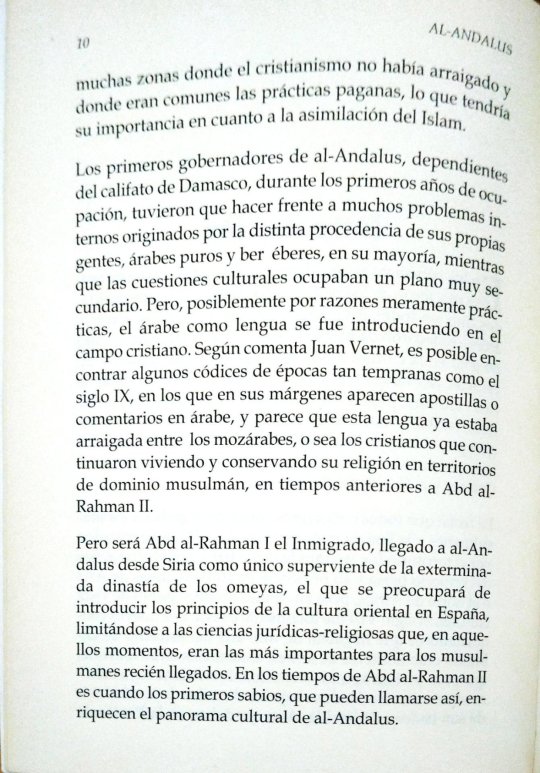
many areas where Christianity had not taken root and its importance regarding the assimilation of Islam.
The first governors of al-Andalus, dependent on Caliphate of Damascus, during the first years of occupation
had to face many enormous internal problems, originated by the different origins of their own people, Arabs
and berebers, mostly, while cultural issues occupied a very secondary level. But, possibly for purely practical reasons, Arabic as a language was introduced into the Christian field. According to Juan Vernet, it is possible to find
some codices from times as early as the 9th century, that in its margins appear apostilles or comments in Arabic,
and it seems that this language was already rooted among the Mozarabs,
that is, the Christians who continued to live and preserve their religion in Muslim-dominated territories, in times
before Abd al-Rahman II.
But it will be Abd al-Rahman I the Immigrant, who arrived in al-Andalus from Syria as the only survivor of the exterminated Umayyad dynasty, the one who will be concerned with introducing the principles of oriental culture in
Spain, limiting itself to the legal-religious sciences that, in those moments, were the most important for the newly Muslims
arrived. It was during the time of Abd al-Rahman II that the first wise men, who can be called that, enrich the cultural landscape of al-Andalus.

Poets, doctors, philosophers, mathematicians, geographers, undefeated generals...All of them will give al-Andalus and Europe a series of works that, by their importance will be translated, searched, accepted and will serve as a basis for the western culture and Renaissance ideas, in such a way that many of the great sages of the Italian Renaissance considered that all knowledge of the time came from Muslim Spain, which all the wise men were of Andalusian origin. And when the political decline and the disintegration of the caliphate, will not stop birth, grow and develop distinguished minds that will continue to maintain,for a long time, the prestige of al-Andalus. Curiously, this situation will be repeated throughout the history of Spain, when the Arab occupation just be a memory. The Spanish Golden Age will coincide with decadence of the Austrias, when the country loses its pre-ponderance in Europe, and with the disaster of '98, with the loss for Spain of its last colonies, will produce a cultural and scientific renaissance that has been called the Silver age.
Through the pages of this book we want to highlight those figures who occupied a predominant place in the history of al-Andalus, although not all of them were necessarily Muslims, since that in that cultured and tolerant al-Andalus, many Jews and some other Christians showed their genius, and of those who, often, we know more about his works than about his biography. But whatever religion they had, they were all, after all, Andalusians, born and raised in the extensive lands of al-Andalus. As a matter of curiosity we will include some groups of characters
anonymous people who, due to their surprising
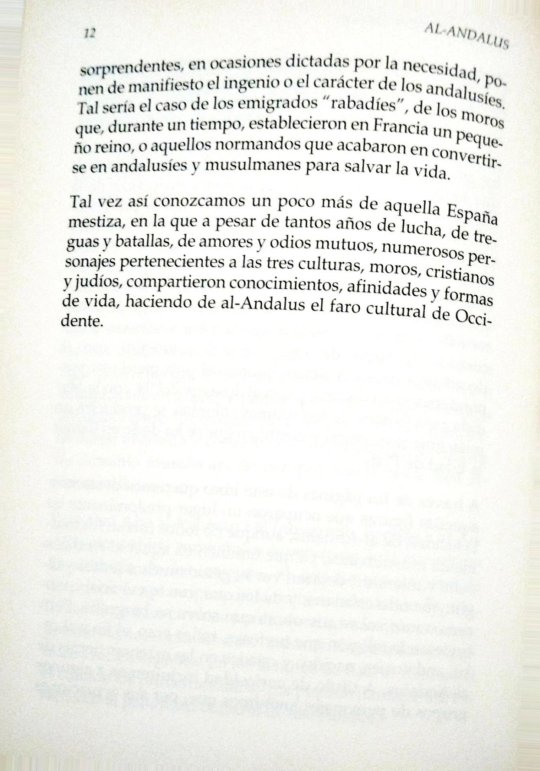
actions, on occasions dictated by necessity, they reveal the ingenuity or character of the Andalusians. Such would be the case of the "rabadíes", of the Moors who, for a time, established a small kingdom in France, or those Normans who ended up becoming Andalusians and Muslims to save their lives.
Perhaps this way we will learn a little more about that crossbred Spain, in which despite so many years of struggle, truces and battles, mutual loves and hates, numerous characters belonging to the three cultures, Moors, Christians and Jews shared knowledge, affinities and forms of
life, making al-Andalus the cultural beacon of the West.

The precursors of al-Andalus
Count Don Julián
The conquest of Morocco had been carried out quickly, but shallow. The Berbers were only subdued after a fierce resistance, defeated by an ambitious general who had just been appointed governor of Ifriqiya and Maghrib. His successes in these lands
They would prepare the ground for him to be the one to set his eyes and, also
his troops, over Gothic Spania. It was Musa ben Nusayr.
Musa, with the help of one of his sons, took possession of Tangier, and demanded that the subjugated tribes hostage to educate them in the new faith, which in turn, became propagandists of Islam, leaving in the conquered Morocco
Arab lieutenants, including General Tariq ben Ziyad, he turned to Ifriqiya. But it seems that the Ceuta square remained
in the hands of a Christian, the so-called Count Don Julián, who would have a
determining role in this entire story. We could consider it as a precursor of that al-Andalus that was about to be born.
#bookblr#book scans#historyblr#history books#al andalus#al andalus. personajes históricos#al andalus. historical figures#history#spanish history#musa ibn nusayr#tariq ibn ziyad#conde don julián#count don julián#count julian
26 notes
·
View notes
Note
Who is more powerful Isabella of Castile or Ferdinand of Aragon ? Or they have same power ? Are they only joint monarchs of Spain ?
I think it depends on how you look at it… Isabella was the sole owner of the Crown of Castile, which was bigger and richer than the Crown of Aragon, but Ferdinand became its co-ruler on the account of his marriage to her. (It’s worth mentioning he had his own claim, but Isabella’s was stronger.) He was the sole owner and ruler of the Crown of Aragon, Isabella was just his consort, making him the embodiment of the union between the two kingdoms. His interests in Italy made him a rival to be reckoned with, and his influence in Castile certainly enhanced his chances to win.
Isabella enhanced his power, and he helped her to get the throne and establish herself as queen since she wasn’t the obvious heir by any means. I think they were very powerful together and no one of them could be as powerful on their own.
There was another couple, Urraca I of Leon and Alfonso I of Aragon, she was the queen of Leon and Castile and he was the king of Aragon, but they didn’t get along and didn’t build anything together, so I will say Isabella and Ferdinand were the only joint rulers of the lands that formed Spain.
34 notes
·
View notes